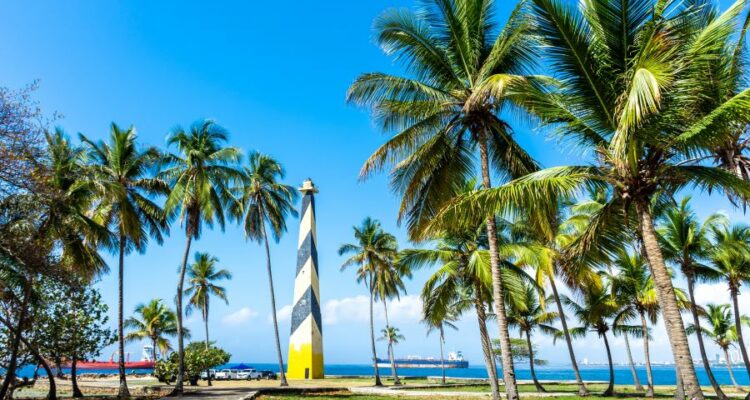Santo Domingo, the heart of the Dominican Republic, is a city where old-world charm intertwines with modern vibrancy. While its renowned landmarks narrate tales of its storied past, there lies a mosaic of hidden gems often overshadowed by the tourist trail.
Venturing off the beaten path in this Caribbean metropolis unveils intimate experiences, from bustling artisanal markets to serene green oases. In the alleys, by the cliffs, or amidst the cacophony of local bazaars, these lesser-known spots beckon travelers with a promise of authentic Dominican soul. This journey delves into these overlooked treasures, guiding the curious traveler through the true essence of Santo Domingo.
Calle El Conde

El Conde Street by Mariordo licensed under CC BY-ND 4.0
Nestled in the heart of the Zona Colonial, Calle El Conde pulsates with life. This pedestrian-only street is aat the heart of Santo Domingo’s daily rhythm. While many visitors flock to the obvious landmarks, like the Catedral Primada de América or the Parque Colón, the real magic of Calle El Conde lies in its lesser-known corners.
Quaint cafes serve aromatic Dominican coffee, while local artisans proudly display their creations at pop-up stalls. Here, the harmony of casual banter, distant merengue beats, and the scents of street food creates a multi-sensory experience. Don’t rush – take a leisurely stroll, strike a conversation, or simply people-watch from one of its many benches.
Jardín Botánico Nacional
A haven of green in the midst of urban Santo Domingo, the Jardín Botánico Nacional offers a refreshing escape. Wander through its themed gardens, from the serene Japanese section to the vibrant orchid display. The lily-covered ponds are a haven for meditative souls, and the towering palm trees stand as a testament to the island’s tropical essence. Birds chirp overhead, adding a musical undertone to this verdant retreat. This botanical garden isn’t just a place to admire nature — it’s a sanctuary that tells the story of the Dominican Republic‘s rich biodiversity.
Parque Mirador del Sur
Overlooking the azure stretch of the Caribbean Sea, Parque Mirador del Sur offers both tranquility and panoramic views. Frequented more by locals, this linear park is the perfect spot for morning jogs, bicycle rides, or picnics. As the sun sets, the hues of the sky paint a mesmerizing backdrop against the city’s silhouette. The gentle sea breeze and the soft rustle of trees provide a calming atmosphere, making it an ideal spot to relax after a day of exploration.
Mercado Modelo
Venture into the vibrant chaos of Mercado Modelo to truly immerse yourself in Dominican culture. Rows of stalls display everything from handcrafted jewelry to aromatic spices. As you navigate the aisles, the scents of herbs mingle with the sounds of bartering. Artisans showcase their crafts, making it an ideal place to pick up a singular souvenir. Beyond the tangible goods, it’s the energy of the market — the blend of tradition and daily life — that captivates the soul.
Barrio Chino

Barrio Chino – China Town in Santo Domingo by Apex Travel licensed under CC BY-ND 4.0
Santo Domingo’s Chinatown, or Barrio Chino, is a delightful blend of Dominican and Chinese cultures. The dragon archway heralds your entrance into a world where Asia meets Caribbean. As you wander the streets, notice the Chinese lanterns swaying gently above local food stalls selling both fried plantains and dim sum. The murals, painted with scenes of both cultures, showcase the harmony of this distinctive neighborhood. It’s more than just a place — it’s a cultural fusion brought to life.
You Might Also Enjoy: Discover Santiago and the Flavors of the Dominican Republic
Hostos Street

Photo: Public Domain CCO
A stone’s throw from the more frequented sites in Zona Colonial lies Hostos Street, a corridor of creativity. The street buzzes with the sounds of artisans at work, chiseling, painting, and molding their wares. From vibrant canvases to handcrafted jewelry, the variety is truly stunning. Chatting with the local craftsmen not only provides insight into their art but also offers a deeper connection to the Dominican spirit. Each workshop, each artist, tells a story waiting to be discovered.
FAQs:
Q: How safe is Santo Domingo for tourists?
A: Santo Domingo is generally safe for tourists, but like any city, it’s wise to be cautious. Avoid poorly lit areas at night and be aware of your surroundings.
Q: Is English widely spoken in Santo Domingo?
A: Spanish is the primary language. While many people in the tourism sector speak English, it’s helpful to know basic Spanish phrases for more authentic experiences.
Q: What currency is used in Santo Domingo?
A: The Dominican Peso (DOP) is the official currency. Major credit cards are accepted in many places, but cash is recommended for local markets.
Q: When is the best time to visit Santo Domingo?
A: The ideal months are December through April, avoiding the peak hurricane season and benefiting from the more pleasant weather.
Q: Is local transportation easily accessible?
A: Yes, there are taxis and “guaguas” (local buses). And ride-sharing is available through apps, including Uber and Cabify. However, be cautious and negotiate taxi fares in advance.
Q: Are there dress codes for religious or historical sites?
A: Generally, modest attire is recommended for religious sites. For churches, covering shoulders and wearing knee-length attire is respectful.
Q: Can I drink tap water in Santo Domingo?
A: It’s advisable to drink bottled water. While tap water is treated, tourists might not be accustomed to it.




